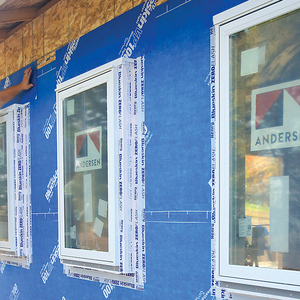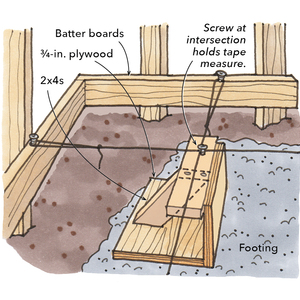condensation behind fiberglass insulatio
In the nw room of our house we are building we have condensation behind the insulation. we have 6 inch walls and 6 inches of insulation. the attic is fully insulated but we found the plywood to be wet behind the wall insulation. the outside of the house has only 5/8 inch plywood and tyvek right now. we are at out wits end trying to find out what the problem is. we have removed and reinstalled all the insulation in the ceiling and the wall to check for problems in that area. everthing seems to be correct. Help.



















Replies
It sounds like the new room is currently under construction, and as such, does that mean there is no drywall up yet? If so, it may be an issue of moisture availability, that is a plentiful supply of moisture is readily available from the rest of the house and there is nothing to slow the moisture down from penetrating the fiberglass batts. In my area (central Indiana) a 2x6 wall insulated with f-glass, sheathed on the outside with OSB/plywood and finished with painted drywall on the inside works fine because the painted drywall effectively slows the passage of moisture into the wall cavity. On the other hand, the OSB/ply on the exterior can breathe moisture out quicker than the drywall allows it to enter, so the wall cavity stays dry. Your situation sounds as if the wall cavity is open on the inside and until it is closed in, you will probably have moisture issues in the wall cavities, but it will eventually dry out.
thanks for the information. we were wondering if the time lapse between putting up the dry wall and painting it would be a problem with the condensation. I am really tired of putting up this stuff and taking it down again. seems like we are getting no where in a hurry. It would be about a 2 week stretch between putting up the dry wall and painting it. thanks again.
I don't think you should be worrying too much over this. Yes, things are wet now, but you can't do much short of move out of the house and shut the place down, and that's just not practical. Things will dry out as construction gets the walls closed up. Putting up the drywall and finishing it will limit the moisture availability greatly by stopping air movement, that alone is a big transport mechanism. Just work to get things closed in buttoned up. Best wishes.
It sounds like you don't have a vapor barrier and you're probably heating with a propane space heater? Don't bother putting the insulation in until you're almost ready to put up the VB and wallboard.
happy?
Moisture behind and inside walls is typically always caused by lack of building ventilation, ie humidity goes to the lowest enviroment the same as heat goes to cold,
When ever the actual humidity outside is lower than inside, the humidity tries to go to the lower enviroment, = outside, but gets stuck behind the vapor barrier on your exterior wall then when the temperature from outside is colder the "dew point" is about 1" inside your insulation, the moisture condenses (ex.= single pain glass everyone has seen somewhere water on the insideglass and outside glass is dry)and you have water in the wall= 48 hours = strong mold condition= typical new problem since we tightened our buildings.
Their is a new ASHRAE 62.2 Residential ventialation code adopted July 2003, not being enforced yet nationally but address "tight construction methods" like yours for the exact reason you have. hope it helps.
You NEED aprofessional to come in and determine if its a ventilation problem or a crack in the wall . Good Luck.
"Moisture behind and inside walls is typically always caused by lack of building ventilation, ie humidity goes to the lowest enviroment the same as heat goes to cold,When ever the actual humidity outside is lower than inside, the humidity tries to go to the lower enviroment, = outside, but gets stuck behind the vapor barrier on your exterior wall then when"Not exactly.Unless you reduce the amount of humidity inside to that outsdie you can still have a problem.And most homes don't have vapor barriers on the outside.It is really a combination of moisture drive, air leakage, the relative permability of both interior and exterior surfaces and the ability of surfaces to dry.wwww.buildingscience.comLook at frenchy's problem.
I agree with you also, thinking that since still under construstion moisture heavy in wood and still trying to dry our= vapor movement hitting "Dew popint" Thanks for your info also, Ken H
Thanks to all who answered my question. I now have the problem under control and things are looking up. Appreciate all your good advice. Fleetsailor
The outside of the area has plywood sheathing and tyvek only right now - no siding? Not knowing where you are or what the weather conditions are there, it sounds like you have a vapor drive from the outside in.
Tyvek stops bulk water, not water vapor. If the outside is cool and humid and the inside is warm and dry, the vapor drive is going towards the interior. The first cold surface the vapor reaches to condense on is the plywood.
The job wasn't finished yet so the vapor barrier was not intact. You were probably adding free airborne moisture to the interior all winter by using temporary fuel fired heaters without venting them
Welcome to the
Taunton University of Knowledge FHB Campus at Breaktime.
where ...
Excellence is its own reward!